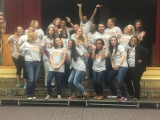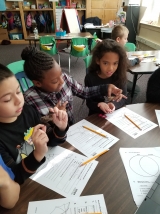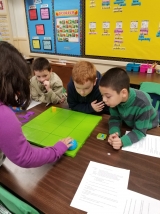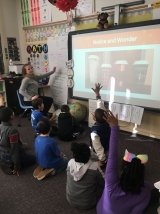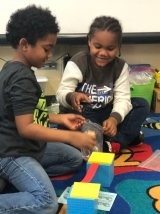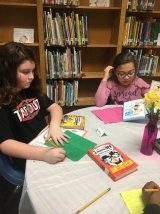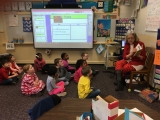-
Category 3
Selected in 2020
-
Grades: pre k - 5
School Setting: suburban
Town Population: 7,056
Student Enrollment: 173
Student Demographics:
Black/African American: 28.8%
Teacher/Student Ratio: 1:14.2
White/Caucasian: 49.4%
Hispanic: 12.2%
Hawaiian/Pacific Islander: 0%
Asian: 1.3%
Native American: 0%
Other: 8.3%
% Reduced Lunch: 100%
% ELL Learners: 12.2%
Founded: 1918 -
PRINCIPAL:
Kimberly Powell -
CONTACT:
7 Naglee Avenue
Sandston, VA 23150
804-328-4055
kfpowell@henrico.k12.va.us
Sandston Elementary School
Sandston, VA
Raising expectations and ensuring students know they are loved is tantamount to changing our school culture."


- Describe specific programs in place to ensure that families are involved in the success of your school and students.
- Monthly, Sandston holds events to engage families to teach them how to assist their children. Sandston holds an interactive and themed reading night, math night, STEM night, Cookies with Santa Night, and a transition night. At each of these events, we provide students an opportunity to apply what they know and we provide families opportunities to engage with the school. We also have back to school night and parent teacher conference opportunities throughout the school year. We offer a STEM based summer program that we offer first to our most vulnerable students and then extra slots are offered to students who need summer support to maintain their learning. During the program students work on cross-curricular STEM projects they present to their families in a STEM Fair. Transportation and all costs are covered. We had 100% participation in this event. The children are so excited to show their work to their families and the families are so proud of their students.
- Describe the most successful activity your school has initiated to strengthen ties to your community.
- We hold team building activities with Richmond Ropes, and field trips to both the Children’s and Science Museums. We hold the Sandston Carnival and Career Day, focusing on team building skills and career exploration. We hold a STEM-a-Palooza where students explore careers offered in STEM fields. After school, we host a board game club where children play games to enhance collaboration and critical thinking skills. Bricks4Kidz teaches students how to integrate STEM activities. Sandston holds summer school for students, to build math and reading skills and incorporate STEM activities for students. Students are provided with materials they need to be successful in summer school. Each student has an individualized learning experience to make sure they strengthen their weaknesses in specific areas. Students have input into what they learn to make certain we cover areas they feel they need. This also offers an opportunity to close gaps and build bridges of success to the next grade-level.
- Describe your philosophy of school change or improvement.
- At the core of any major improvement process is analyzing data and conducting a root cause analysis.This is also ensuring you are collecting appropriate data through multiple data sources. Once we did this, we were able to really focus on barriers to student success and identify “show stopper” areas that needs to be fixed before you can move forward. At Sandston, our show stoppers were off task student behavior and teacher retention. Once we discovered this, we were able to establish positive behavior supports, teachers felt better supported and stayed. Once teacher retention increased, we were able to build stable and consistent programming that we continuously enhanced through a constant data lens. In order to increase student outcomes, you have to take an honest look at your current landscape in order to critically analyze data and identify any barriers.
- What are your school’s top two goals for the next year?
- The COVID -19 pandemic is a major concern. Our school division has been virtual since March of 2020. One of the areas affected by the pandemic is the halt of the summer school program. During the regular school year, it has been more challenging for us to ensure students have a positive learning environment and appropriate in-person support as the students learn from their homes. Staff and administration continue to reach out to parents and guardians to model ways for parents to support students in their virtual learning environments. Our number one goal next year will be to gather all the data we can and prioritize students’ needs to develop a plan based on the needs of each student. Our second goal will be to develop extended learning opportunities for students to get as much support as possible. We have a mountain of work in front of us, but together and with great understanding, we will be able to get this train back on track.
- What is the single most important factor in the success of your school that others could replicate?
- We used data to identify needs and celebrate the successes of our students. We used PD and PLCs to learn how to better engage students and families who may be under-resourced, experiencing homelessness, in need of individualized learning opportunities or suffering trauma. Once teachers became more skilled in these areas, their confidence grew and they began to see data not as a judgement on their teaching, but as a growth opportunity. We encouraged students to monitor their own growth. Teachers worked with students to assist them in setting and reflecting on goals. We held a summer program designed to provide our students experiencing homelessness ways to access STEM opportunities. . When we eliminated barriers to participation such as cost and transportation, more of our students could attend. By thinking of our most vulnerable students first, we were able to design a program that provided life ready skills to all students in our school, instead of a small group of students.
- Describe the program or initiative that has had the greatest positive effect on student achievement, including closing achievement or opportunity gaps, if applicable.
- Our initiative of focusing and embracing every student has helped us increase student achievement. We use data to help teachers and students set learning goals which in turn has been the true powerhouse in closing opportunity gaps. Each student connects with an adult, outside of their classroom teacher, and becomes the cheerleader and coach for that student. If a child experiences challenges, emotionally or academically, their champion will assist them in getting the skills and knowledge to help them climb that mountain. Our summer school program focuses on our students experiencing homelessness and helps these students maintain skills they have learned throughout the year while also giving them a safe, stable environment with meals and needed materials. This extends the learning for our students and continues connections and positive school experiences.
- Explain how ESEA federal funds are used to support your improvement efforts.
- ESEA federal funds are used to support improvement efforts based on data. The school receives a certain amount and the division provides additional resources for our school such as bookrooms, classroom libraries, math manipulatives and iPads. We use ESEA funds for two additional staff persons, reading coach, and family advocate, both who have worked with students and staff to increase outcomes, Further, we look at grade level data trends as well as school data trends to determine resources we need to support learning. Our data indicated that our most unstable students, students experiencing homlessness under McKinney Vento, needed to have significant supports to increase outcomes. Our ESEA funds support homeless students and we were able to use funding during the summer that included providing these students transportation, food, teachers from their own school who they are familiar with, and incentives for attending the Summer School STEM Academy program.
- Identify the critical professional development activities you use to improve teaching and student learning.
- Professional development is ALWAYS based on data. In the summer, we go through data and decide next steps. By looking at data, aggressively removing barriers, and providing stability in leadership and teaching staff, we started to grow. Our first focus was understanding students in poverty where we identified barriers such as transportation to summer school. Our next focus was building self-regulation in our students and then to building growth mindsets through goal setting. Once these pieces were in place, we were able to dig into academic data where trends told us that reading fluency issues and mathematical thinking/number sense were areas of need. We provided professional development phonemic/phonetic awareness and Math Workshop strategies in teaching math that included powerful math talks and discourse. Every professional development decision is based on our data analyses. We have continued to use PLCs to continue the learning.
- Describe how data is used to improve student achievement and inform decision making.
- Data is used frequently in our building. Teachers meet twice weekly to plan for math and reading. During these separate meetings, teachers review weekly student data and develop lesson plans to fill gaps and move learning forward. Administration holds reading and math data meetings monthly where the grade level reports where their students are, what they are doing to address needs, and identifies any resources needed. During these meetings, we look at multiple data points, and triangulate the different points of data to identify trends. The school then holds a monthly meeting with all staff where we talk about data trends and use this to determine any needed staff development or resources needed. We also use attendance data as well as information from champions working with students.
- Describe your school culture and explain changes you’ve taken to improve it.
- Raising expectations and ensuring students know they are loved is tantamount to changing our school culture Each day, our teachers start off with a morning meeting where students practice skills such as greeting and listening to each other, shaking hands, and asking meaningful questions. This work builds a collaborative, family community of scholars poised to learn. Every student has a champion outside of their classroom teacher as a mentor. The champion will talk to the student about their goals and their progress. The champion can be their previous teacher, secretary, custodian, principal, resource teacher, or interventionist but not their current teacher. This has greatly impacted our building and provided us with information to better serve each student.
Stats
-
Category 3
Selected in 2020
-
Grades: pre k - 5
School Setting: suburban
Town Population: 7,056
Student Enrollment: 173
Student Demographics:
Black/African American: 28.8%
Teacher/Student Ratio: 1:14.2
White/Caucasian: 49.4%
Hispanic: 12.2%
Hawaiian/Pacific Islander: 0%
Asian: 1.3%
Native American: 0%
Other: 8.3%
% Reduced Lunch: 100%
% ELL Learners: 12.2%
Founded: 1918 -
PRINCIPAL:
Kimberly Powell -
CONTACT:
7 Naglee Avenue
Sandston, VA 23150
804-328-4055
kfpowell@henrico.k12.va.us


